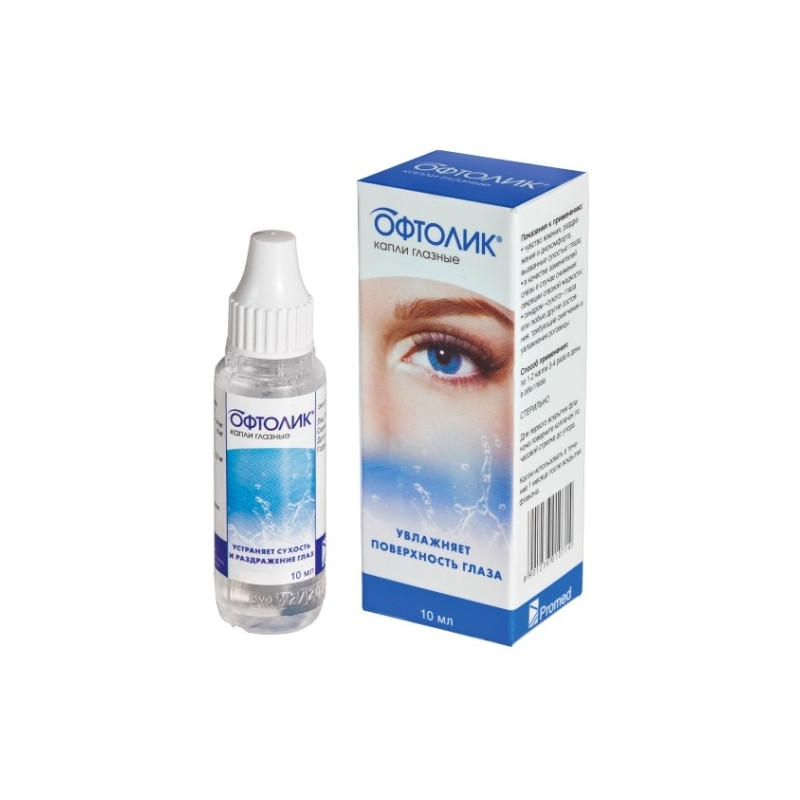



 All payments are encrypted via SSL
All payments are encrypted via SSL
 Full Refund if you haven't received your order
Full Refund if you haven't received your order
Trade name of the drug: Oftolik®
Dosage Form: eye drops
Active substances:
Polyvinyl alcohol 14 mg,
Povidone 6 mg,
Excipients:
benzalkonium chloride 0.1 mg, disodium edetate 1.0 mg, sodium chloride 8.4 mg,
water for injection up to 1 ml.
Transparent, colorless or slightly yellowish solution.
Pharmacotherapeutic group: keratoprotector
Pharmacodynamics
The drug has a protective effect on the cornea with reduced secretion of the tear fluid or with an increase in evaporation of the tear film.
Polyvinyl alcohol and povidone have the properties of a lubricant, which reduces irritation and redness of the eye. These substances reduce the tension of the surface of the tear film, easily covering the surface of the eye, and prevent the occurrence of tearing tear film. Polyvinyl alcohol has properties similar to mucin, producing conjunctival glands. It helps to soften and lubricate (moisturize) the surface of the eye, increases the stability of the tear film.
Through a study of bioavailability, it was found that after instillation of two drops of Oftolik® in each eye, the concentration of drug components in the plasma 4 hours after use remains below the possible limit of quantitative determination (10 ng / ml).This allows us to conclude that the systemic absorption of drug components from the surface of the eye when using Oftolik® eye drops is minimal.
Hypersensitivity to the drug.
1-2 drops 3-4 times a day in both eyes, depending on the severity of symptoms.
Wash hands before use.
Shake the bottle and remove the cap. Ensure that the pipette tip does not touch the skin or the surface of the eye to prevent infection.
Throw back the head, pull the lower eyelid down, turn the bottle upside down and put the required number of drops in the conjunctival sac.
Allergic reactions to the drug components are possible.
Polyvinyl alcohol undergoes esterification reactions characteristic of compounds with secondary hydroxy groups. It breaks down in strong acids and softens or dissolves in weak acids and alkalis. In high concentrations, the substance is incompatible with inorganic salts, especially phosphates and sulfates. The precipitation of 5% polyvinyl alcohol can be caused by reaction with phosphates.Gel formation from a solution of polyvinyl alcohol can occur in the presence of borax.
Povidone solution is compatible with many inorganic salts, natural and synthetic resins and other substances. It interacts in solution with sulfathiazole, sodium salicylate, salicylic acid, phenobarbital, tannin and other substances. The effectiveness of some preservatives, such as thiomersal, for example, may decrease due to the formation of complexes with povidone.
Do not use the drug if the color of the solution has changed or it has become cloudy.
Ensure that the tip of the vial does not touch any surfaces during use. After use, close the vial with a cap.
You should stop using the drops and consult a doctor if:
when using drops the pain increases;
vision deteriorates;
symptoms persist for more than 72 hours;
eye redness and irritation persists.
Drops contain benzalkonium chloride, so contact lenses should not be worn for 20 minutes after using the drops.
Sufficient experience in the use of the drug during pregnancy and lactation is not. Use in pregnant and lactating mothers is possible only as prescribed by the attending physician, if the expected therapeutic effect exceeds the risk of possible side effects.
Release form
At 10 ml of the drug in a plastic dropper bottle with a screw cap.Each bottle dropper along with instructions for use are placed in a cardboard box.
Storage conditions
In a dry, dark place at a temperature not higher than 25 ° C. Do not freeze.
After instillation, close the vial tightly.
Keep out of the reach of children.
Shelf life
3 years.
Drops to use within 45 days after opening the bottle. Do not use after the expiration date printed on the package.
Pharmacy sales terms
Over the counter.
